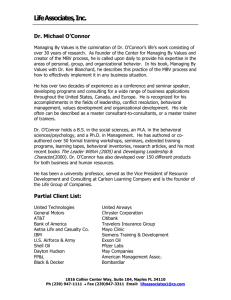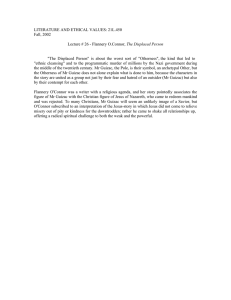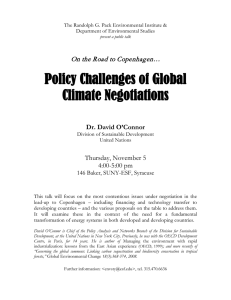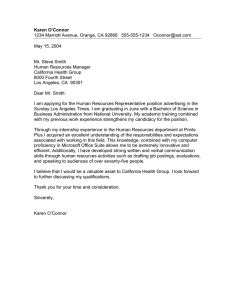O'Conner Project
advertisement
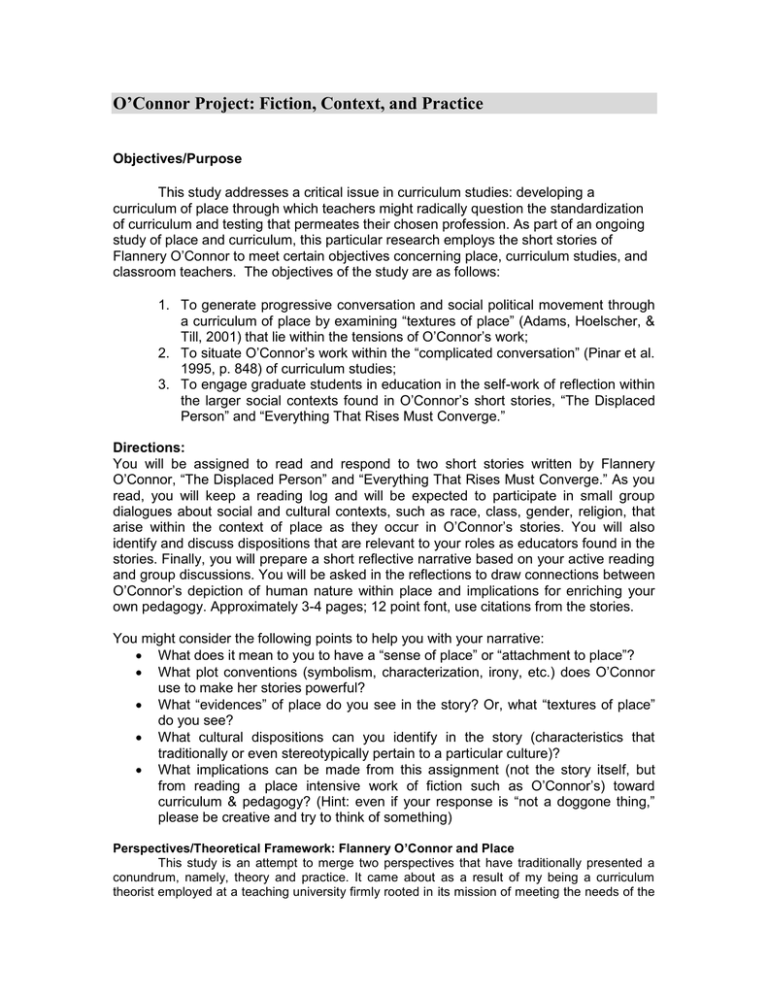
O’Connor Project: Fiction, Context, and Practice Objectives/Purpose This study addresses a critical issue in curriculum studies: developing a curriculum of place through which teachers might radically question the standardization of curriculum and testing that permeates their chosen profession. As part of an ongoing study of place and curriculum, this particular research employs the short stories of Flannery O’Connor to meet certain objectives concerning place, curriculum studies, and classroom teachers. The objectives of the study are as follows: 1. To generate progressive conversation and social political movement through a curriculum of place by examining “textures of place” (Adams, Hoelscher, & Till, 2001) that lie within the tensions of O’Connor’s work; 2. To situate O’Connor’s work within the “complicated conversation” (Pinar et al. 1995, p. 848) of curriculum studies; 3. To engage graduate students in education in the self-work of reflection within the larger social contexts found in O’Connor’s short stories, “The Displaced Person” and “Everything That Rises Must Converge.” Directions: You will be assigned to read and respond to two short stories written by Flannery O’Connor, “The Displaced Person” and “Everything That Rises Must Converge.” As you read, you will keep a reading log and will be expected to participate in small group dialogues about social and cultural contexts, such as race, class, gender, religion, that arise within the context of place as they occur in O’Connor’s stories. You will also identify and discuss dispositions that are relevant to your roles as educators found in the stories. Finally, you will prepare a short reflective narrative based on your active reading and group discussions. You will be asked in the reflections to draw connections between O’Connor’s depiction of human nature within place and implications for enriching your own pedagogy. Approximately 3-4 pages; 12 point font, use citations from the stories. You might consider the following points to help you with your narrative: What does it mean to you to have a “sense of place” or “attachment to place”? What plot conventions (symbolism, characterization, irony, etc.) does O’Connor use to make her stories powerful? What “evidences” of place do you see in the story? Or, what “textures of place” do you see? What cultural dispositions can you identify in the story (characteristics that traditionally or even stereotypically pertain to a particular culture)? What implications can be made from this assignment (not the story itself, but from reading a place intensive work of fiction such as O’Connor’s) toward curriculum & pedagogy? (Hint: even if your response is “not a doggone thing,” please be creative and try to think of something) Perspectives/Theoretical Framework: Flannery O’Connor and Place This study is an attempt to merge two perspectives that have traditionally presented a conundrum, namely, theory and practice. It came about as a result of my being a curriculum theorist employed at a teaching university firmly rooted in its mission of meeting the needs of the practitioner. Teacher education faculty have developed standard syllabi and objectives for all courses in the program, a concept that in itself runs counter to curriculum theory’s central premise of curriculum as the interpretation of lived experience. In this study I transgress levels of standardization by integrating a reflective strand into a best practices course for middle and secondary graduate students in education. I was inspired toward subversion after reading Cole’s (1993) account of having his Harvard Business School students respond to two of O’Connor’s stories in a seminar on literature and ethics. I suggest to my students that it is through disruption and discomfort, which O’Connor so richly employs, rather than solidifying standardization through which they might discover their own “best practices.” As O’Connor’s work may be considered in literary and various cultural criticisms, it may also be woven into interdisciplinary and intersubjective studies of place, primarily in the ways her anagogical perspective informs larger social and cultural contexts. Her pedagogy is found in her fiction, her speeches and essays, and her personal correspondence, in which she discloses individual encounters with grace. Scholars agree upon O’Connor’s affinity for the countrified Southern fundamentalist Protestant’s intensity toward religion and fervent belief in sin. As she explores the mystery of the individual within social and cultural contexts, she implicitly establishes the need for a collective, political accounting, thereby advancing a curriculum of place. In order to generate further progressive conversation and social political movement through a curriculum of place, I contemplate the anomalies, “textures” (Adams, Hoelscher, & Till, 2001), if you will, of Southern place that lie within the tensions of O’Connor’s notion of mystery and manners. Both mystery and manners are important elements of her anagogical world view focused on the intervention of grace in the physical world, or, as she terms it, that “which has to do with the Divine life and our participation in it” (MM, p. 72, 111). Because she overtly contextualized her themes within the natural world, a connection exists between these themes and the study of place. O’Connor believed that these manners of formality and civility have been important to racial relations in the South. It was not the manners, she maintained, that inhibited interpersonal relations; rather, it was their lack of grounding in love. If relations were to improve, she reckoned, the reconstruction of social relations would not be found in the civil rights activism that she witnessed in the mid-fifties, but in the initiation of a new code of manners of mutual charity. She believed that were such a code in place, when charity failed in the day-to-day, as she was certain it would, the code of manners would remain to bolster relations until they were stabilized. The tensions between mystery and manners in Southern place hold a complex interplay of love and rage, violent grace. O’Connor becomes part of the “complicated conversation” (Pinar et al. 1995, p. 848) of curriculum studies in the distortions and breaking moments of sudden grace that she portrays. She crafts freaks and misfits to subvert the pastoral, flowing quietness of a mythic South incapable of sight because of its intransigence. She wrote, “When I am asked why Southern writers write about freaks, I reply it is because we are still able to recognize one” (MM, p. 44). The freak that we know exists of and within place; we do too, and so we can recognize him. O’Connor reveals the price of restoration to the freak of self-in-place the by rekindling his or her— and our—diluted sense of evil, allowing both self and place to be considered in light of the grace of Mystery and the mystery of grace. Conclusions and Significance of the Study Dominant social and cultural constricting conceptions of Southern place are apparent in O’Connor’s portrayal of the South, particularly its violences and inhibitive codes of manners. By not telling about but observing and bearing witness, O’Connor is able to “render the highest possible justice to the visible universe” (MM, p. 80). O’Connor wrote about the region in her accent, not to illustrate the region, but to gain access to the “true country” (CFO, p. 110) for which it is an entrance. “The Georgia writer’s true country is not Georgia…One uses the region in order to suggest what transcends it, that realm of mystery which is the concern of the prophets” (CFO, p. 110). Because they are not stories about the South, realities about the place emerge from the author’s strategic use of accent to achieve essence; the violent blow of grace upon her characters is violence inflicted within Southern place, for example. Expected findings of this study will be that it meets the aforementioned objectives. First, students will engage with the O’Connor work by not only identifying social and cultural contexts within which she discusses place and people, but also by connecting these contexts to their own situatedness as teachers within place. In this way, O’Connor’s work will have been employed in the continuance of complicated curriculum conversation. Finally, readings and discussion will foster progressive conversation and social political movement—within the setting of our class and, it is hoped, in my students’ classrooms—through a curriculum of place, by examining the “textures of place” (Adams, Hoelscher, & Till, 2001) that lie within the tensions of O’Connor’s work. O’Connor Project: Fiction, Context, and Practice Name(s): Rubric Criteria 2 6 10 Overall Understanding of Concepts Narrative does not generate conversation concerning a curriculum of place. Little evidence illustrates an understanding of the “textures of place” that lie within the tensions of O’Connor’s work; narrative does not situate O’Connor’s work within curriculum studies; little evidence of reflection of larger social contexts present in O’Connor’s short stories. Narrative does not address content in light of classroom implications or teaching. Narrative generates some conversation concerning a curriculum of place. Evidence generally illustrates an understanding of the “textures of place” that lie within the tensions of O’Connor’s work; narrative somewhat situates O’Connor’s work within curriculum studies; some evidence of reflection of larger social contexts present in O’Connor’s short stories. Narrative generally addresses content in light of classroom implications, including teaching. Narrative clearly generates conversation concerning a curriculum of place. Evidence clearly illustrates an understanding of the “textures of place” that lie within the tensions of O’Connor’s work; narrative situates O’Connor’s work within curriculum studies; clear evidence of reflection of larger social contexts present in O’Connor’s short stories. 1 3 5 Contributes some to group discussions about social and cultural contexts that arise within the context of place as they arise in O’Connor’s stories. Some discussion of Contributes strongly to group discussions about social and cultural contexts that arise within the context of place as they arise in O’Connor’s stories. Discusses dispositions Classroom Implications Small Group Discussions Contributes little or none to group discussions about social and cultural contexts that arise within the context of place as they arise in O’Connor’s stories. Narrative clearly addresses content in light of classroom implications, including teaching. Mechanics & Style Total Fails to discuss dispositions relevant to educators as they may be identified in the stories. Late, does not follow all directions, several grammatical and mechanical errors; work is poorly organized and presented. dispositions relevant to educators as they may be identified in the stories. relevant to educators as they may be identified in the stories. On time, follows most directions, a few grammatical and mechanical errors; work is adequately organized and presented. On time, follows directions, free of grammatical and mechanical errors; work is well organized and presented.
